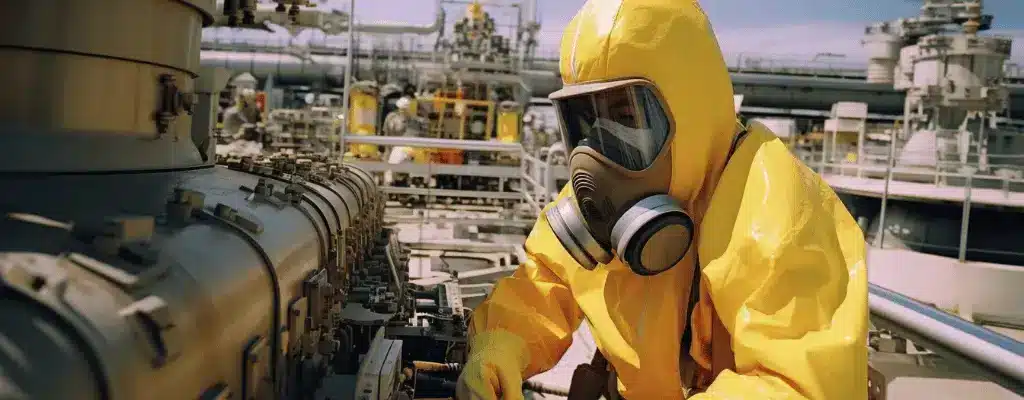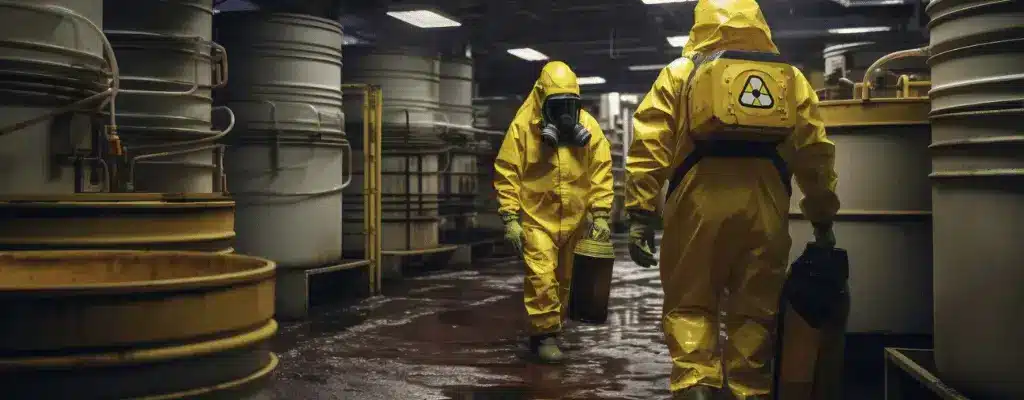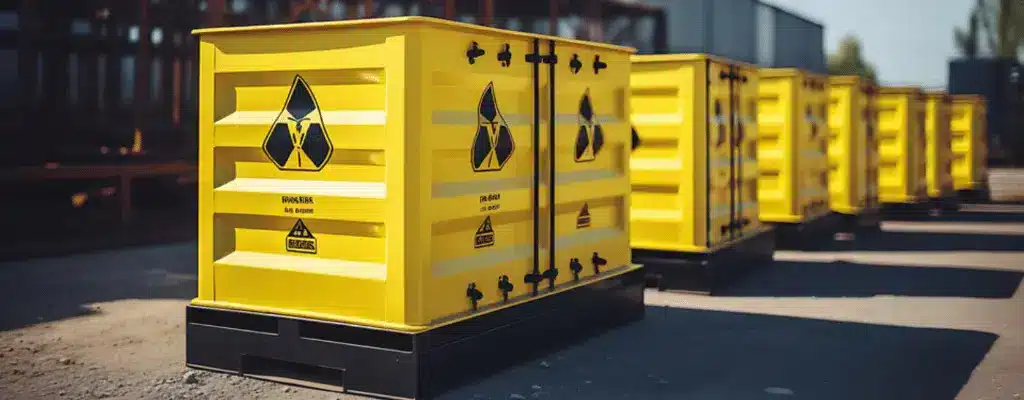The transportation of radioactive and explosive materials is one of the most sensitive and high-risk areas of transport in the world. These materials, due to their dangerous and potentially destructive characteristics, require the strictest adherence to international and national standards, laws, and regulations at all stages of handling. Any negligence or failure in the transport of these materials can have irreparable and catastrophic consequences.
In this regard, choosing a specialized, experienced, and safety-committed transport company is of utmost importance. Mobin Asa Tarabar, with years of experience in transporting hazardous and sensitive materials, is recognized as one of the few companies with the necessary permits and expertise to transport radioactive and explosive materials in Iran.
At Mobin Asa, safety is the cornerstone of all our activities, and by utilizing specialized and trained personnel, advanced equipment, and a dedicated transport fleet, we ensure that your sensitive shipments will reach their destination with the highest level of safety and security.
This comprehensive article specifically examines the subject of transporting radioactive and explosive materials and, while providing key and essential information, introduces Mobin Asa Tarabar’s distinctive and responsible services in this critical area. By reading this article, you will become familiar with the vital importance of safety and expertise in transporting these materials and, with complete confidence, will choose Mobin Asa as your safe and reliable business partner.
What are Radioactive and Explosive Materials?
Definition and Types of Radioactive Materials
Radioactive materials are defined as materials that emit ionizing radiation, either naturally or artificially. These radiations can be harmful to living organisms and the environment. Radioactivity arises from the instability of the nuclei of atoms of certain elements, which, in order to achieve stability, release particles and energy in the form of radioactive rays.
Radioactive materials are divided into different categories based on the type of radiation emitted and their half-life (the time it takes for half of the atoms of a radioactive substance to decay):
- Low-Level Waste (LLW): These materials have the lowest level of radioactivity and include hospital, laboratory, and industrial waste with low levels of contamination.
- Intermediate-Level Waste (ILW): These materials have a higher level of radioactivity than LLW and include ion exchange resins, chemical sludge, and activated components of nuclear power plants.
- High-Level Waste (HLW): These materials have the highest level of radioactivity and include spent nuclear fuel and waste from nuclear fuel processing.
- Transuranic Waste (TRU): These materials contain elements heavier than uranium and have a very long half-life.
Definition and Types of Explosive Materials
Explosive materials are substances that react rapidly and violently, producing a large volume of gas, heat, and pressure. This reaction can occur as a sudden and massive explosion. Explosives are classified into various types based on their sensitivity, explosive power, and application:
- Primary Explosives: Highly sensitive to shock, heat, and friction, and easily detonated. These materials are used as primers and initiators of explosions. (e.g., lead azide, mercury fulminate)
- Secondary Explosives: Less sensitive than primary explosives and require a detonator to explode. These materials are used as the main explosive charge in ammunition and industrial explosives. (e.g., TNT, dynamite, C4)
- Incendiary Materials: Materials that burn rapidly and produce intense heat and flame. (e.g., thermite, magnesium)
- Propellants: Materials that burn at a high rate but do not have a massive explosion. These materials are used in fireworks and some military ammunition. (e.g., black powder, nitrocellulose)
Hazards and Characteristics of These Materials
Both radioactive and explosive materials pose serious potential hazards to humans and the environment.
Hazards of Radioactive Materials:
- Radiation: Ionizing radiation emitted from radioactive materials can damage living cells and lead to various diseases, including cancer.
- Environmental Contamination: The release of radioactive materials into the environment can contaminate water, soil, and air and remain in the environment for a long time.
- Long Half-Life: Some radioactive materials have a very long half-life and remain radioactive for thousands or millions of years.
Hazards of Explosive Materials:
- Explosion: The explosion of explosive materials can cause widespread destruction, injury, and death.
- Fire: The explosion of explosive materials can lead to extensive fires.
- Release of Toxic Gases: Some explosive materials produce toxic and dangerous gases upon explosion.
Common Characteristics of Radioactive and Explosive Materials:
- Dangerousness: Both types of materials are extremely dangerous and require extreme caution and care in handling and transport.
- Need for Strict Regulations: The transport and storage of these materials are subject to strict international and national laws and regulations.
- Importance of Expertise and Experience: The safe transport of these materials requires expertise, experience, and sufficient knowledge.
Simple Table to Show Types of Materials and Their Hazards
| Material Type | Example | Main Hazards |
|---|---|---|
| Radioactive | Uranium, Plutonium, Cesium-137, Cobalt-60 | Radiation, environmental contamination, cancer |
| Explosive | TNT, Dynamite, C4, Nitroglycerin | Explosion, fire, injury, death, toxic gas release |
The Importance of Compliance with Laws and Regulations in the Transport of Radioactive and Explosive Materials
International Laws and Standards (IAEA, IMDG, ADR, IATA)
Due to the extreme hazards of transporting radioactive and explosive materials, strict adherence to international and national laws and regulations in this area is of vital importance. These laws and standards are designed to protect human lives, the environment, and public property, and violation of them can result in severe legal and criminal consequences.
Some of the most important international laws and standards in the field of transporting radioactive and explosive materials are:
- IAEA (International Atomic Energy Agency) Regulations for the Safe Transport of Radioactive Material: The International Atomic Energy Agency’s regulations for the safe transport of radioactive materials are the most comprehensive and authoritative international reference in this field, which sets out the general principles and criteria for the safe transport of radioactive materials.
- IMDG Code (International Maritime Dangerous Goods Code): The International Maritime Dangerous Goods Code (IMDG) is a set of regulations and guidelines for the safe transport of dangerous goods by sea, which also includes radioactive and explosive materials.
- ADR (European Agreement concerning the International Carriage of Dangerous Goods by Road): The European Agreement concerning the International Carriage of Dangerous Goods by Road (ADR) sets out the regulations for the road transport of dangerous goods in Europe and some other countries, and also includes radioactive and explosive materials.
- IATA Dangerous Goods Regulations (DGR): IATA Dangerous Goods Regulations (DGR) are a collection of regulations and guidelines for the safe air transportation of dangerous goods, developed by the International Air Transport Association (IATA), and includes radioactive and explosive materials.
National Laws and Regulations for Transporting These Materials
In addition to international laws and standards, each country also has its own specific national laws and regulations regarding the transport of radioactive and explosive materials. These laws and regulations are usually developed based on international standards and adapted to the specific conditions and requirements of each country.
In Iran, the Iranian Atomic Energy Organization is the main authority for supervising and issuing licenses for nuclear and radioactive activities, responsible for developing and implementing regulations for the transport of radioactive materials. Also, the Ministry of Defense and Armed Forces Logistics and the Law Enforcement Force of the Islamic Republic of Iran also have responsibilities in the field of laws and regulations for the transport of explosive materials.
Mobin Asa Tarabar, with full knowledge of all international and national laws and regulations related to the transport of radioactive and explosive materials, complies with them accurately and responsibly in all stages of transport. We obtain the necessary permits from the relevant authorities and, in close cooperation with regulatory bodies, ensure that the transport of your shipments is carried out in accordance with the latest laws and regulations.
Responsibilities of the Shipper, Carrier, and Consignee
Compliance with the laws and regulations for the transport of radioactive and explosive materials is the shared responsibility of the shipper, carrier, and consignee. Each of these parties has its own role and duties in this process:
- Shipper’s Responsibilities:
- Correct Classification of Materials: The shipper is responsible for the accurate classification of materials based on their type, level of radioactivity, or explosive hazard in accordance with relevant regulations.
- Appropriate Packaging and Labeling: The shipper is obliged to package the materials safely and standardly and to affix the necessary warning labels and markings on the packages.
- Providing Accurate and Complete Information: The shipper must provide accurate and complete information about the nature, hazards, and transport methods of the materials to the carrier.
- Obtaining Necessary Permits: The shipper is responsible for obtaining the necessary permits from the relevant authorities for sending the materials.
- Carrier’s Responsibilities (Mobin Asa Tarabar):
- Safe Transport in Compliance with Regulations: The carrier is responsible for transporting the materials safely and in accordance with all relevant laws and regulations.
- Use of Appropriate Equipment and Vehicles: The carrier must use special and standard equipment and vehicles for transporting radioactive and explosive materials.
- Personnel Training: The carrier is obliged to fully train its personnel in the safe transport of these materials.
- Responding to Emergency Situations: The carrier must have established plans for emergency situations and train its personnel to deal with potential incidents.
- Consignee’s Responsibilities:
- Safe Receipt and Unloading of the Shipment: The consignee is responsible for receiving and unloading the shipment safely and in accordance with relevant instructions.
- Proper Storage and Warehousing: The consignee is obliged to store and warehouse the materials correctly and safely after receiving them.
- Responsible Use: The consignee is responsible for using radioactive and explosive materials responsibly and in accordance with legal purposes.
Mobin Asa Tarabar, by accepting full responsibility for the transport of your shipments, will be by your side as a reliable business partner and will make every effort to carry out safe and legal transport.
Radioactive and Explosive Materials Transport Services at Mobin Asa Tarabar
Mobin Asa’s Expertise and Experience in Transporting These Materials
Mobin Asa Tarabar proudly announces that it has valuable expertise and experience in the field of transporting radioactive and explosive materials. Our brilliant track record, valid permits, and satisfied customers are a testament to our capability and commitment in this sensitive area.
Mobin Asa’s Strengths in Transporting Radioactive and Explosive Materials:
- Long History and Practical Experience: Years of activity in the field of transporting hazardous materials and gaining practical experience in transporting various radioactive and explosive materials.
- Specialized and Experienced Team: Utilizing specialized, trained personnel with valid certificates in the field of transporting hazardous materials.
- Full Compliance with Laws and Regulations: Full and up-to-date knowledge of all international and national laws and regulations related to the transport of radioactive and explosive materials and strict adherence to them at all stages of transport.
- Special Equipment and Facilities: Possessing a special transport fleet equipped with all necessary safety and security facilities for transporting these materials.
- Strong Relationships with Regulatory Bodies: Close cooperation with atomic energy organizations, the Ministry of Defense, and law enforcement and obtaining the necessary permits legally and quickly.
- Comprehensive Liability Insurance: Coverage with comprehensive liability insurance for the transport of radioactive and explosive materials in order to compensate for potential damages and ensure the financial security of customers.
Mobin Asa’s Permits and Certifications
Mobin Asa Tarabar, as a responsible transport company, has obtained all the necessary permits and certifications for transporting radioactive and explosive materials from the relevant authorities. These permits and certifications demonstrate our commitment to complying with safety and quality standards and regulations in transporting these materials.
Some of Mobin Asa’s most important permits and certifications:
- Radioactive Materials Transport Permit from the Iranian Atomic Energy Organization: This permit gives Mobin Asa the legal permission to transport radioactive materials within the country and demonstrates the compliance of our activities with the regulations of the Atomic Energy Organization.
- Explosive Materials Transport Permit from the Ministry of Defense and Armed Forces Logistics: This permit allows Mobin Asa to transport explosive materials in compliance with specific conditions and regulations and confirms our expertise and capability in the safe transport of these materials.
- ISO 9001 Quality Management System Certificate: This certificate demonstrates the establishment of a comprehensive quality management system at Mobin Asa and our commitment to providing quality services in accordance with international standards.
- ISO 45001 Occupational Health and Safety Certificate: This certificate demonstrates Mobin Asa’s special attention to the safety and health of personnel and the workplace and our efforts to create a safe and healthy environment for employees.
Mobin Asa, by providing legal and valid documents and documentation, provides peace of mind to its customers in the field of safe and legal transport of radioactive and explosive materials.
Mobin Asa’s Special Equipment and Facilities
Mobin Asa Tarabar has provided special equipment and facilities for transporting radioactive and explosive materials, which maximizes the level of safety and security of transport:
- Special Transport Fleet: Includes trucks and trailers specifically designed for transporting hazardous materials with resistant bodies, automatic fire extinguishing systems, ventilation and air filtration systems, and advanced communication equipment.
- Containers for Transporting Radioactive and Explosive Materials: Steel containers resistant to impact, heat, and radiation penetration, with secure and traceable locking and sealing systems.
- Personal Protective Equipment (PPE): Providing complete personal protective equipment for transport personnel, including protective clothing, respirators, radiation- and explosion-proof gloves, safety helmets, and safety shoes.
- Radiometry and Dosimetry Devices: Precise measuring devices for radioactivity and personnel dose for continuous monitoring and control of radiation levels and ensuring the health of employees.
- Advanced GPS Tracking Systems: Real-time tracking of the location and condition of the shipment through GPS systems and online sensors and 24-hour monitoring of the route and transport status.
The Transport Process at Mobin Asa
The process of transporting radioactive and explosive materials at Mobin Asa Tarabar is carried out with careful planning and includes the following steps:
- Request and Expert Consultation: Dear customers, by contacting our expert consultants, register your request for transporting radioactive and explosive materials and benefit from free expert advice on laws, regulations, packaging, transport route, and other related matters.
- Shipment Review and Assessment: The Mobin Asa expert team carefully reviews and assesses the nature and characteristics of the shipment, potential hazards, legal requirements, and packaging and transport standards.
- Obtaining Necessary Permits: Mobin Asa takes the necessary steps to obtain all required permits from the relevant authorities (Atomic Energy Organization, Ministry of Defense, Law Enforcement, etc.) on behalf of customers.
- Transport Route Planning and Design: The best and safest transport route is designed by our experts, taking into account security, traffic, weather conditions, and environmental considerations.
- Packaging and Labeling: If needed, packaging and labeling services are provided by Mobin Asa’s experienced team in accordance with international and national standards.
- Fleet and Equipment Preparation: The special transport fleet and necessary safety and security equipment are prepared and inspected for transporting the shipment.
- Safe Transport and Under Supervision: The transport operation is carried out by specialized drivers and under the continuous supervision of Mobin Asa’s operations control team. Real-time tracking of the shipment and monitoring of transport conditions is carried out continuously.
- Shipment Delivery and Documentation: At the final destination, the shipment is delivered safely and with all relevant documentation to the consignee.
- Post-Transport Support and Follow-up: Mobin Asa’s customer support team, after delivery of the shipment, is also ready to answer questions and provide support services to dear customers.
Methods of Transporting Radioactive and Explosive Materials
Land Transport
Land transport is the most common method of transporting radioactive and explosive materials over short and medium distances. Special trucks for transporting hazardous materials are the main vehicles used in this method.
Land transport of radioactive and explosive materials requires adherence to special safety and security measures, including:
- Choosing Safe and Low-Risk Routes: Avoiding busy routes, residential areas, population centers, and sensitive points in designing the transport route.
- Police Escort (if necessary): In some cases and based on the type and level of hazard of the materials, a police escort is required to increase transport security.
- Speed and Stop Limits: Strictly adhering to speed limits and avoiding unnecessary stops along the transport route.
- Preparation for Emergency Situations: Having established plans and necessary equipment to deal with emergency situations such as fire, accidents, and material spills.
- Continuous Communication with the Operations Control Center: Maintaining continuous radio and telephone communication with Mobin Asa’s operations control center and reporting the transport status regularly.
Sea Transport (If Necessary)
Sea transport is used to transport large volumes of radioactive and explosive materials over long international distances (where possible and permitted). Special ships for transporting hazardous materials and specialized marine containers are the main tools for sea transport of these materials.
Sea transport of radioactive and explosive materials is subject to the strict regulations of the IMDG Code and international maritime conventions.
Safety and Security Measures for Sea Transport of Radioactive and Explosive Materials:
- Packaging and Loading in Accordance with the IMDG Code: Strict adherence to the packaging and loading requirements for hazardous materials based on the IMDG Code.
- Use of Licensed Ships: Utilizing ships with valid certificates and permits for transporting hazardous materials.
- Compliance with Safety Regulations in Ports and Terminals: Full compliance with safety and security regulations at the origin and destination ports and during loading and unloading of the shipment.
- Continuous Monitoring and Tracking: Tracking the ship’s position and the condition of the cargo during the sea voyage through satellite systems.
- Preparation for Maritime Emergency Situations: Having established plans and necessary equipment to deal with emergency situations such as fire, sinking, and material spills at sea.
Air Transport (If Necessary)
Air transport is less common and is only used in very special and necessary cases for transporting radioactive and explosive materials (with special and limited permits). Cargo aircraft specially designed for transporting hazardous materials and specialized air containers are the means of air transport for these materials.
Air transport of radioactive and explosive materials is subject to the strictest international regulations of IATA DGR and aviation security requirements.
Safety and Security Measures for Air Transport of Radioactive and Explosive Materials:
- Very Strict Restrictions on the Type and Amount of Transportable Materials: Air transport of radioactive and explosive materials is subject to very strict limitations on the type, quantity, and hazard level of the materials.
- Extremely Resistant and Safe Packaging: The packaging of materials must be such that it maintains its safety and integrity under harsh flight conditions and changes in pressure and temperature.
- Thorough and Multi-Layered Security Inspections: Shipments are subject to thorough and multi-layered security inspections before being loaded onto the aircraft.
- Restrictions on Airports and Flight Paths: Air transport of these materials is only possible to specific airports and through pre-determined air routes.
- Full Preparedness for Air Emergency Situations: Having established plans and necessary equipment to deal with emergency situations such as fire, plane crashes, and material spills in the air.
Packaging and Labeling of Radioactive and Explosive Materials
The Importance of Proper and Standard Packaging
Proper and standard packaging is the most crucial factor in the safety of transporting radioactive and explosive materials. The packaging must be designed and manufactured in such a way that it can protect its contents under normal transport conditions and even in emergency situations, and prevent the release of hazardous materials into the environment.
Characteristics of Proper Packaging for Radioactive and Explosive Materials:
- High Physical Resistance: Resistance to impact, pressure, vibration, and abrasion during transport.
- Proper Insulation: Insulation against heat, moisture, water penetration, and other destructive environmental factors.
- Radiation Shielding (for radioactive materials): Using radiation-absorbing materials and designing the packaging in a way that minimizes the output radiation.
- Non-Reactivity with Internal Materials: The packaging material must be compatible with the radioactive and explosive materials and not cause any unwanted chemical reactions.
- Ability to Withstand Emergency Situations: Resistance to fire, explosion, and potential falls.
- Ease of Handling and Transport: Proper design for easy and safe handling and transport using standard equipment.
Labeling and Marking Procedures
Correct and clear labeling and marking of packages containing radioactive and explosive materials is crucially important for informing all personnel involved in transport and raising awareness of potential hazards.
Labeling and Marking Requirements:
- Use of International Standard Labels: Using international hazard labels (based on the GHS system) with specific colors, shapes, and symbols for each type of hazardous material (radioactive and explosive).
- Placement of Labels in Appropriate and Visible Locations: Affixing labels on all visible surfaces of the packages so that they are easily recognizable.
- Use of Warning Signs: Using additional warning signs such as “Radioactive Materials,” “Explosive Materials,” “Caution,” etc., in various languages.
- Inclusion of Essential Information: Including essential information on the packages, such as the proper shipping name of the material, UN number, hazard class, net and gross weight, shipper and consignee names, etc.
- Durability of Labels Against Environmental Conditions: Using labels that are resistant to moisture, heat, abrasion, and various weather conditions.
Safety in the Transport of Radioactive and Explosive Materials
Preventive Measures and Risk Management
Land transport is the most common method of transporting radioactive and explosive materials over short and medium distances. Special trucks for transporting hazardous materials are the main vehicles used in this method.
Key Preventive Measures:
- Risk Assessment: Identifying, assessing, and analyzing all potential hazards associated with the transport of radioactive and explosive materials at each stage of the process.
- Design and Implementation of Safety Programs: Developing and implementing comprehensive safety programs including instructions, procedures, checklists, and necessary training for personnel.
- Regular Inspection and Maintenance of Equipment: Periodic technical inspection and preventive maintenance of all equipment and vehicles to ensure their proper and safe operation.
- Training and Awareness: Continuous training of personnel in the field of safe transport of hazardous materials, emergency response, first aid, and proper use of safety equipment.
- Communication and Coordination with Relevant Authorities: Establishing continuous communication and coordination with the Atomic Energy Organization, the Ministry of Defense, law enforcement, and other regulatory and emergency response agencies.
- Review and Continuous Improvement: Periodic review of safety programs and operational procedures and making necessary improvements based on experience and new findings.
Emergency Actions and Incident Response
Despite all preventive measures, the possibility of unforeseen incidents occurring during the transport of radioactive and explosive materials always exists. Full preparedness for emergency situations and the development of specific procedures for dealing with potential incidents are undeniable necessities.
Emergency Actions and Incident Response:
- Emergency Response Planning (ERP): Developing a comprehensive Emergency Response Plan (ERP) including job descriptions, responsibilities, communication methods, emergency phone numbers, evacuation plans, and access routes.
- Equipment and Facilities for Dealing with Incidents: Providing equipment and facilities necessary to deal with potential incidents, such as appropriate fire extinguishers, absorbent and neutralizing materials, spill containment and collection equipment, and first aid equipment.
- Personnel Training for Emergency Response: Training personnel on how to identify and report incidents, fire extinguishing, spill containment, first aid, and emergency evacuation.
- Regular Drills and Exercises: Conducting regular drills and exercises to prepare personnel and assess the effectiveness of emergency response plans.
- Immediate Contact with Emergency Services: Establishing immediate contact with firefighters, emergency medical services, police, and other emergency responders in the event of an incident.
- Reporting to Relevant Authorities: Prompt and accurate reporting of the incident to the Atomic Energy Organization, the Ministry of Defense, and other relevant authorities in accordance with legal procedures.
- Post-Incident Assessment and Investigation: Conducting a thorough assessment and investigation after an incident to identify root causes, learn lessons, and improve safety and emergency response plans.
Frequently Asked Questions (FAQ)
What types of materials are classified as radioactive and explosive materials?
Radioactive materials are materials that emit ionizing radiation and are divided into LLW, ILW, HLW, and TRU categories based on their level of radioactivity. Explosive materials are substances that react rapidly and produce an explosion, and are divided into primary, secondary, incendiary, and propellant categories based on their sensitivity and explosive power. Examples of radioactive materials include uranium and plutonium, and examples of explosive materials include TNT and dynamite.
What are the most important international and national laws and regulations for transporting these materials?
The most important international laws and regulations include the IAEA Regulations for the Safe Transport of Radioactive Material, IMDG Code, ADR, and IATA DGR. National laws and regulations in Iran are developed and implemented by the Iranian Atomic Energy Organization and the Ministry of Defense and Armed Forces Logistics. Strict adherence to these laws and regulations is mandatory for the safe transport of radioactive and explosive materials.
What services does Mobin Asa Tarabar provide for transporting these materials?
Mobin Asa Tarabar offers a comprehensive set of specialized services for transporting radioactive and explosive materials, including:
- Land, sea, and (in special cases) air transport of radioactive and explosive materials.
- Obtaining necessary permits from relevant authorities.
- Standard packaging and labeling.
- Providing a special and equipped transport fleet.
- Utilizing specialized and trained personnel.
- Planning a safe transport route.
- Comprehensive liability insurance coverage.
- Expert consultation and 24/7 support.
Mobin Asa, with its expertise and experience, guarantees the safe and legal transport of your sensitive shipments.
How can I request a quote from Mobin Asa Tarabar for transporting these materials?
To request a quote and receive free consultation regarding the transport of radioactive and explosive materials from Mobin Asa Tarabar, you can contact us through the following methods:
- Phone Call to Sales Experts: The company’s phone numbers are listed on the Mobin Asa website.
- Submitting an Online Request Form: The cargo transport request form is accessible on the radioactive and explosive materials services page of the Mobin Asa website.
- Sending an Email to the Company: The company’s email address is available in the contact us section of the website.
- In Person visit to the Head office or branches: Mobin Asa’s office address is listed on the website.
Our experts will contact you as soon as possible and provide the necessary information and guidance.









